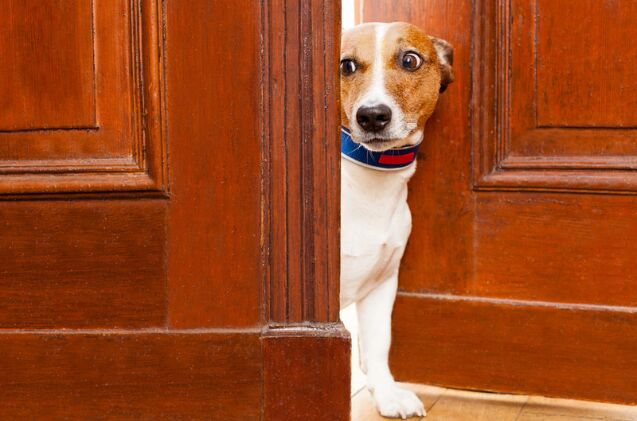How Do I Know if My Dog is Afraid?

Experts often talk about the importance of reading your dog’s body language to reduce fear, stress, and anxiety. But do you sometimes struggle to identify if your dog is really scared or if you’re just reading into a situation?
Many common dog behaviors can be misinterpreted – fear or calm, comfort or stress. If this sounds familiar, don’t worry. We are here to help! This post dives deep into the basics of canine communication and body language. We’ll highlight some of the more subtle body language cues, behavioral changes, and vocalization that you should be looking out for.
Plus, we’ll look at the most common situations that trigger fear in dogs, why these situations can be frightening, and how to comfort and support your dog moving forward.
What’s the ultimate goal? Ensuring you have the information needed to build your dog’s confidence, improve your communication, and help them enjoy a world free from unnecessary fear and anxiety. Dedicate the time and energy today to set your dog up for long-term success (avoiding potential health complications from too much stress).
Common Signs of Fear and Anxiety in Dogs
Life as a pet parent would be much easier if our pups could speak up and tell us exactly what they think in each situation. Unfortunately, that’s not the reality we live in. Instead, we must learn to pick up on their non-verbal communication to build a strong and trusting relationship with our furry friends.
Here are a few ways they may be trying to tell you that they are feeling “off” or nervous:
Body Language
One of the most important ways our pets communicate their feelings is through their body language. This includes the way they stand, the way they move, how they hold their ears or their tail, and so much more. Some signs will be obvious, while others will be more subtle.
Here are some of the more common signs of fear and stress related to body language:
- Excessive panting
- Yawning
- Showing teeth
- Lip-licking
- Puckering of the lips
- Whale eyes (showing the whites of the eyes)
- Large, dilated pupils
- Ears backward or pressed forward
- Tail up and stiff or down tucked between the legs
- Cowering or standing with the body low to the ground
- Attempting to hide
- Displacement behaviors (sneezing, itching)
- Shaking or trembling
- Submissive urination
Behavior Changes
In addition to changes in how your dog stands or positions their body, you may notice some behavioral changes.
You may find that your dog tries to back away or avoid their trigger. On the other hand, your dog may become reactive towards a trigger by jumping or lunging at it. Both these reactions signify stress or anxiety, highlighting the importance of getting to know your dog as an individual. For example, we have two male dogs in our house. When presented with a trigger, Lucifer will hold his ground while Indiana tends to back away or hide.
You may also notice changes in how your dog reacts to objects or activities in their regular life. Many dogs, even those who are highly food-driven, will be reluctant to eat or take treats when stressed.
Vocal Cues
Finally, while we are focusing mainly on non-verbal communication, there are some vocalizations that could help you recognize that something is wrong. Dogs who are nervous, anxious, or afraid may bark at their trigger. They may also whine to show that they are uncomfortable.
Is My Dog Scared or Just Excited?
For some dogs, stress can lead to heightened energy and hyperactivity. They start jumping or lunging at their trigger and lack self-control. In the moment, it may appear like your dog is just excited. The best way to see if your dog is simply over-excited is to step back from the situation and try calming them down. Talk to them in a soft but firm voice, ask them to sit, and see if they can still control their energy and response to the trigger(s) around them.
At the same time, watch for any of the other signs listed above. When you take a step back and lower the threshold slightly, you may be able to pick up on more subtle cues to help you understand how your dog is feeling.
To help you better understand this, picture your dog jumping and lunging at another dog you encounter at the park. When you create distance between you and the other dog, allowing your dog to settle down slightly, you can then look for other indications of fear or anxiety. Are their pupils dilated? Where are their ears positioned? Do you notice that they are trembling slightly or licking their lips? These signs are easier to pick up when you aren’t in the heat of the moment.
How Do You Make a Scared Dog Less Scared?
Now that we have given you several warning signs to look out for, helping you identify that your dog is afraid or uncomfortable, let’s discuss how to address the situation appropriately. This includes how to react immediately and tips and tricks to prevent your dog from being scared or fearful in the future. After all, no one wants to go through life living in fear!
Take Steps to Reduce Triggers
First and foremost, if your dog is actively displaying fear and anxiety, get them out of the situation. This will be relatively easy if the source of their fear is a physical object or person. Create space and move away from the trigger. However, if the trigger is something less concrete, you may need to do some creative thinking. Here are some examples:
Situation 1: Your dog shows they are afraid of another dog you passed at the park. The dog itself is the trigger. This means you can reduce the difficult feelings your dog is experiencing by putting distance between them and the strange dog.
If they are visually triggered, you may only have to walk around the corner of a building to block their view. If the sound of another dog is also triggering, you may need to move further away until they can no longer hear the barking or whining.
Situation 2: Your dog is afraid of thunderstorms. Obviously, you aren’t going to pack up and leave town every time that a thunderstorm moves into the area. Instead, focus on distracting your dog and minimizing the trigger as much as possible.
Move into an inner room of your home or apartment, away from windows where the storm can be seen. This will also help to muffle the sound. Turn on some calming music. You can also offer a distraction like a lickmat, which has been shown to have a calming effect.
Create a Safe Space (Where Possible)
As we just touched on in the thunderstorm example, there are ways you can create a safe, calm environment for your dog with fewer triggers. In that situation, you moved your dog to a safe place to reduce the trigger. However, you can often prevent your dog from feeling scared or anxious by taking this step proactively.
If you have a dog afraid of strangers and loud noises, keep this in mind. When hosting people at your home, set up a room for your dog that is separate from your guests. Include your dog’s favorite and most comforting items like their bed, crate (if crate trained), or a preferred toy. You can check on your dog periodically through the evening, but ask your guests not to enter the room, allowing it to remain a safe, secure space for your dog to relax.
Avoid Unnecessary Triggers
Another way to prevent your dog from becoming scared is to avoid triggers where possible. If you have a dog who is afraid of larger dogs or dogs they don’t know, bringing them to a dog park on a Sunday afternoon is not their idea of a great weekend. While there is some merit to slowly introducing them to their triggers to help them overcome their fear (more on that below), you don’t want to just jump into the situation causing your dog to be overwhelmed.
Consider Calming Products
Sometimes, your dog’s fear is minimal, or a trigger isn’t completely avoidable. In these situations, you may wish to use a calming product to help them relax and avoid letting the anxiety build up and worsen the situation.
There are many options, ranging from calming treats to pheromone diffusers. To find the products that work best for your dog, you may have to try a few. Monitor how your dog responds and if it has the desired effect. Ensure that you give it time to work. Your dog will not calm down instantly the moment you spray a calming spray if they are fearful and anxious.
Here are some products to consider:
- Zesty Paws Hemp Elements Calming Bites
- Thundershirt Dog Anxiety Jacket
- Happy Hoodie Original Calming Band
- ThunderEssence Essential Oil Calming Spray
- Pheromone Technology Calming Collar
- bSerene Pheromone Calming Diffuser
Training and Counterconditioning
Many fears can be addressed with training and counterconditioning. This will involve behavior modification in which your dog is slowly exposed to their trigger (very slowly) while pairing it with something positive, like their favorite treats or playing with their favorite toy. You can increase the intensity slightly when they are no longer bothered by the trigger at that level. For sounds, this means starting very quietly and slowly raising the volume. For a physical trigger, like a dog or a person, you would begin at a far distance and gradually move closer over time.
Counterconditioning cannot be done overnight or in a single training session. If you are committed to helping your dog overcome their fear, you must be prepared for a lot of work with a long-term goal.
The key is to focus on positive reinforcement. You aren’t punishing your dog for being afraid. If they know that every time they see a large, scary dog, they will be punished, that will only make the experience more stressful. Instead, you are helping them see that the large dog isn’t as frightening by pairing it with a positive emotion.
The counterconditioning process can be complicated and requires a confident understanding of your dog’s thresholds and how to tell if you are pushing them too far. While some experienced dog parents can tackle this solo, it is highly recommended that you consult a dog behaviorist to ensure that you are on the right path.
When to Seek Professional Help
While there are several ways you can help your dog build confidence and overcome their fear and anxiety, there are times when professional intervention may be needed. This can come in the form of a veterinarian prescribing behavioral medications (like anti-anxiety medications) or connecting with a trainer or dog behaviorist.
This is especially important if your dog’s fear manifests in a way that could cause harm to themselves or others in your life. Some dogs respond to extreme anxiety and stress by redirecting these feelings, even snapping at “their person.”
Remember, asking for help doesn’t mean you have failed your dog. It’s quite the opposite. Recognizing that your dog needs more help than you can provide and making an effort to find the proper professional are signs of a responsible and loving dog parent. You are dedicated to your dog’s long-term safety and well-being, which is commendable.
Final Thoughts: Fear and Anxiety in Dogs
One of the most important things you can do for your dog is learn to recognize early signs of fear and anxiety. This empowers you to address the situation appropriately before it escalates into something potentially dangerous or harmful. A thorough understanding of non-verbal communication, like body language and behavioral changes, will make this easier.
If you notice your dog is displaying signs of being scared or fearful, you should immediately take steps to remove them from the situation. This could mean redirecting their attention temporarily as a trigger passes or moving them out of the uncomfortable situation entirely.
The best approach is to learn what triggers fear in your dog and take steps to prevent an uncomfortable situation. This could involve avoiding major triggers and using counterconditioning to teach your dog a healthier approach to the things that scare them. The more you help them build confidence, the happier they will be.
Join the PetGuide community. Get the latest pet news and product recommendations by subscribing to our newsletter here.

Britt Kascjak is a proud pet mom, sharing her heart (and her home) with her “pack” which includes her husband John, their 2 dogs – Indiana and Lucifer – and their 2 cats – Pippen and Jinx. She has been active in the animal rescue community for over 15 years, volunteering, fostering and advocating for organizations across Canada and the US. In her free time, she enjoys traveling around the country camping, hiking, and canoeing with her pets.
More by Britt
























